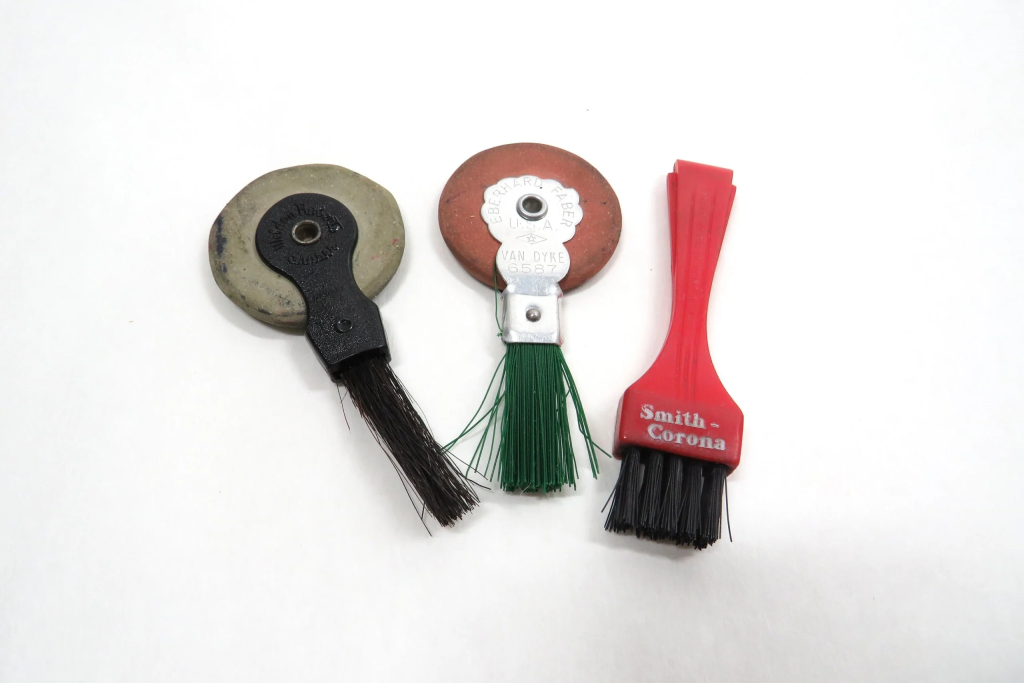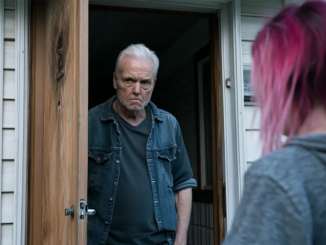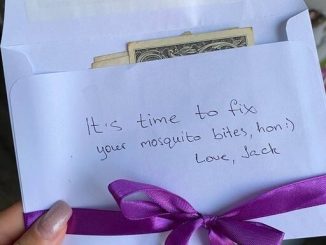What Are Typewriter Eraser Brushes?
The circular objects in the image are typewriter erasers, which came with a small brush attached to them. The erasers themselves were made from soft materials like rubber, often infused with fine abrasives.
This combination was designed to remove ink or typewriter ribbon marks from paper, which was the
primary method of correcting mistakes on a typed document before the advent of white-out or digital editing.

The small brush on the tool was used to gently whisk away the eraser debris left on the paper after erasing a letter or a word. In an age when typewriters ruled the business and literary worlds, these tools were essential to maintaining neat and professional-looking work.
A Snapshot in Time: When Eraser Brushes Were Essential
In the early to mid-20th century, typewriter eraser brushes were as common as correction fluid or digital backspace keys are today. Every typist had one on their desk because, despite their best efforts, mistakes in typing were inevitable. These tools allowed for correcting those mistakes without the need to retype an entire
page.
Back then, carbon paper was often used for making copies, so one mistake could mean fixing multiple sheets of paper. Eraser brushes were gentle enough not to tear the delicate paper yet effective at removing the erroneous marks.
The Decline of the Typewriter Era
With the rise of word processors and eventually personal computers, typewriters
quickly became obsolete. The need for such specialized erasers faded as digital
text allowed for instantaneous editing. Today, these erasers are rare relics from a
time when typing was both an art and a skill.
For those who remember using these eraser brushes, seeing one today is a nostalgic reminder of how much the world of writing and editing has evolved. The phrase “times have changed” has never been truer, especially when comparing the
challenges of fixing a typewritten document to the ease of modern technology’s undo button.
A Niche Collectible
Today, typewriter eraser brushes are considered collectibles. Vintage enthusiasts and lovers of retro office supplies value them for their simplicity and effectiveness. Though they might look out of place in a world dominated by digital devices, they serve as a testament to the ingenuity of past generations and the unique tools
that once supported everyday tasks.
Conclusion: From Essential to Obsolete
For those who’ve never used a typewriter, the tools in the image may seem mysterious, even obsolete. But for older generations, they bring back memories of the rhythmic clacking of typewriter keys, the smell of ink ribbons, and the ever- present eraser brush sitting nearby. Times have certainly changed, and as with many innovations, what was once essential now rests quietly in history’s archives
Teen who went missing in 1998 found alive in neighbor’s cellar

An Algerian man who went missing at the age of 19 was found alive recently, astonishing his family and community.
Omar bin Omran, who disappeared in 1998, is now 45 years old. He was discovered in a neighbor’s cellar, just 650 feet away from his family’s home, according to Al Jazeera.
The discovery ended a 26-year-long mystery that began during the tumultuous period of the Algerian civil war. Given the extended duration of his disappearance, some relatives had presumed him dead. However, his mother, who passed away in 2013, reportedly never lost hope that her son would be found alive.
The suspected captor, a 61-year-old man, was arrested at the scene after attempting to flee, BBC reported. Algeria’s Ministry of Justice condemned the act as “heinous” and confirmed that an investigation is ongoing to uncover the full extent of the circumstances surrounding bin Omran’s captivity.
Currently, Omar bin Omran is receiving comprehensive medical treatment for both physical and psychological traumas, as reported by the BBC. Remarkably, bin Omran revealed that over the past 26 years, he occasionally saw some of his family members but was unable to reach out for help. He claimed that his captor had cast a “spell” on him, rendering him incapable of seeking assistance.
The bizarre and tragic kidnapping was brought to light recently due to an alleged inheritance dispute between the suspect and his brother. The suspect’s brother posted incriminating information on social media, which prompted the National Gendarmerie — responsible for police services in Algeria’s rural areas — to investigate further. This led to a search of the suspect’s house, resulting in the discovery of bin Omran.



Leave a Reply